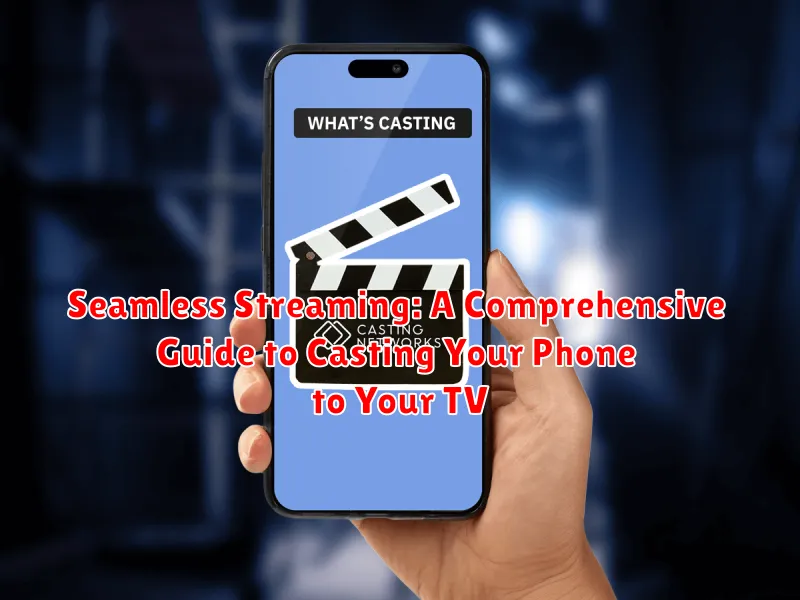In today’s digitally driven world, seamless streaming has become an essential part of our entertainment experience. The ability to cast content from your phone to your TV opens up a world of possibilities, transforming your living room into a personalized cinema, a dynamic gaming hub, or an interactive presentation space. This comprehensive guide will delve into the intricacies of casting your phone to your TV, exploring various methods, addressing common challenges, and providing you with the knowledge to optimize your streaming setup for a truly seamless experience. Whether you’re looking to share photos, watch movies, play games, or deliver presentations, understanding the nuances of screen mirroring and casting is crucial for maximizing your device’s potential.
This guide will cover a range of techniques for casting your phone to your TV, including built-in smart TV features, using dedicated streaming devices such as Chromecast and Roku, and leveraging wireless technologies like Miracast and AirPlay. We’ll explore the advantages and disadvantages of each method, helping you determine the best approach for your specific needs and devices. Learn how to seamlessly stream your favorite content from various applications, troubleshoot potential connectivity issues, and optimize your setup for the highest quality video and audio playback. From basic screen mirroring to advanced streaming techniques, this guide will equip you with the tools and knowledge to transform your entertainment experience and unlock the full potential of your connected devices.
Understanding Different Casting Methods
Casting your phone’s screen to your TV opens up a world of entertainment possibilities. Whether you want to share photos, watch movies, or play mobile games on a larger display, understanding the different casting methods available is crucial for a seamless experience. Choosing the right method depends on your devices and their compatibility.
Several popular methods facilitate this screen sharing. Chromecast built-in, a widely adopted technology, allows direct streaming from compatible apps. AirPlay serves a similar function, primarily for Apple devices, enabling wireless streaming to Apple TV and other compatible receivers. Miracast, another popular standard, offers screen mirroring functionality across a range of devices. Lastly, a direct HDMI cable connection offers a wired, albeit less convenient, option for mirroring your phone’s display.
Each method has its own advantages and limitations. Factors such as video quality, latency, and ease of use vary, influencing which method best suits your needs. Understanding these differences empowers you to make an informed choice and enjoy an optimized viewing experience.
Casting with Built-in Chromecast
Casting with a built-in Chromecast offers a straightforward and reliable method for streaming content from your phone to your TV. This technology eliminates the need for external devices or complicated setups, as the Chromecast functionality is integrated directly into your smart TV.
To initiate casting, ensure both your phone and TV are connected to the same Wi-Fi network. Open a compatible app on your phone, such as YouTube or Netflix. Look for the cast icon, typically represented by a screen with a Wi-Fi signal in the corner. Tap this icon and select your Chromecast-enabled TV from the list of available devices.
Once connected, the content playing on your phone will seamlessly transfer to your TV screen. You can then use your phone as a remote control to pause, play, adjust volume, and navigate content. The advantage of this method is that your phone’s resources are not consumed for mirroring the entire screen, allowing you to multitask or even turn off your phone’s screen while continuing to stream on your TV.
Important Note: Ensure your TV’s firmware is up-to-date for optimal Chromecast performance.
Using AirPlay for iOS Devices
AirPlay is a proprietary protocol developed by Apple that allows you to wirelessly stream audio and video content from your iOS devices (iPhone, iPad, iPod Touch) and Mac computers to an Apple TV or other AirPlay-compatible smart TVs. This offers a seamless way to enjoy content on a larger screen.
To use AirPlay, ensure both your iOS device and Apple TV (or AirPlay 2-compatible smart TV) are connected to the same Wi-Fi network. Open the Control Center on your iOS device. For iPhones with Face ID, swipe down from the top-right corner. For iPhones with a Home button, swipe up from the bottom of the screen. For iPads, the gesture depends on the iPadOS version. You’ll likely swipe down from the top right corner.
Tap the “Screen Mirroring” icon. You will see a list of available AirPlay devices. Select your Apple TV or AirPlay-compatible smart TV from the list. Your iOS device’s screen will then be mirrored on your TV.
To stop AirPlay, open the Control Center again, tap “Screen Mirroring”, and then select “Stop Mirroring”.
Screen Mirroring with Miracast
Miracast offers another way to wirelessly mirror your phone’s screen to your TV. This standard creates a direct peer-to-peer connection between your device and the display, unlike Chromecast which relies on your Wi-Fi network. This means Miracast can be useful in situations where a stable network isn’t available.
To use Miracast, both your phone and your TV must be Miracast-compatible. Many smart TVs and streaming devices have Miracast support built-in. Check your device’s settings to confirm compatibility. On your Android device, you can usually find screen mirroring settings within the display or connection settings. Look for terms like “Wireless Display,” “Screen Mirroring,” or “Cast.” The exact naming can vary depending on your phone’s manufacturer and Android version.
Once you’ve enabled Miracast on both your phone and TV, they should automatically detect each other. Select your TV from the list of available devices on your phone. Be aware that because Miracast creates a direct connection, performance can be affected by interference from other wireless devices. Keeping your phone relatively close to the TV can improve stability.
Connecting via HDMI Cable
While wireless casting methods offer convenience, a direct HDMI connection provides a reliable, lag-free, and often higher-quality viewing experience. This method involves physically connecting your phone to your TV using an HDMI cable and an adapter.
You’ll need an HDMI cable and a compatible adapter that connects to your phone’s charging port. These adapters are commonly available for USB-C, Lightning, and micro-USB ports. Ensure the adapter supports video output, as not all adapters do.
Simply connect the adapter to your phone, then connect the HDMI cable to the adapter and an available HDMI port on your TV. Next, switch your TV’s input source to the corresponding HDMI port. Your phone’s screen should then be mirrored on your TV.
Advantages of using an HDMI cable include minimal lag, superior video and audio quality, and no reliance on network connectivity. Disadvantages include the need for physical cables and adapters, which can be less convenient than wireless solutions.
Troubleshooting Common Casting Problems

Casting issues can be frustrating. Here’s a breakdown of common problems and solutions:
Connectivity Issues
Check your Wi-Fi. Ensure both your phone and TV are connected to the same Wi-Fi network. A weak signal can also disrupt casting. Move closer to your router or consider a Wi-Fi extender. Restart your devices. Power cycling your phone, TV, and router can often resolve temporary network glitches.
Content Not Supported
Some apps may have restrictions on casting certain content due to licensing agreements. Verify app compatibility. Check the app’s documentation or website to ensure it supports casting. Look for alternative methods. If casting isn’t supported, explore alternative solutions like downloading content for offline viewing or using a different app.
Audio/Video Lag or Stuttering
Reduce network congestion. Limit other devices using the same Wi-Fi network during casting. Lower video quality. Streaming in lower resolution can improve performance. Close unnecessary apps. Background apps on your phone can consume resources and impact casting performance.
Optimizing Your Casting Experience for the Best Quality

Achieving a high-quality casting experience involves several key factors. First, ensure your Wi-Fi network is robust and uncongested. A 5GHz network is generally recommended for smoother streaming. Close proximity between your phone, router, and TV can also minimize interference.
Next, consider the video resolution settings on your phone. Higher resolutions demand more bandwidth. If you’re experiencing buffering or lag, try lowering the resolution in your streaming app or device settings.
Closing unnecessary apps running in the background on your phone can free up system resources, further enhancing performance. Additionally, ensure your phone’s operating system and the casting app are up to date. Updates often contain performance improvements and bug fixes that can directly impact casting quality.
Finally, the content itself plays a role. Higher resolution source material will naturally result in a better viewing experience. If possible, choose the highest quality stream available from your content provider.

